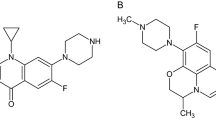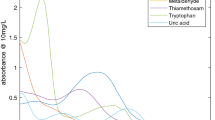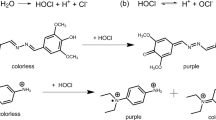Abstract
MARTIN and co-workers1 extended their technique of partition chromatography of the amino-acids to the micro-scale by using filter paper instead of silica gel as the support for the stationary phase (water). We have found that the modified partition chromatogram for penicillin using buffer as the stationary phase2 can also be adapted to the micro-scale by the same change in support. Colour reactions are not readily applicable to locate the positions of the invisible developed zones, so that a microbiological procedure has been used both to identify and to determine approximately the types and amounts of penicillins resolved on the buffered paper strip. The procedure is as follows.
This is a preview of subscription content, access via your institution
Access options
Subscribe to this journal
Receive 51 print issues and online access
$199.00 per year
only $3.90 per issue
Buy this article
- Purchase on Springer Link
- Instant access to full article PDF
Prices may be subject to local taxes which are calculated during checkout
Similar content being viewed by others
References
Consden, R., Gordon, A. H., and Martin, A. J. P., Biochem. J., 38, 224 (1944).
Levi, A. A., and Terjesen, S. G., Brit. Pat. 569844.
Schmidt, W. H., Ward, G. E., and Coghill, R. D., J. Bact., 49, 411 (1945).
Author information
Authors and Affiliations
Rights and permissions
About this article
Cite this article
GOODALL, R., LEVI, A. A Microchromatographic Method for the Detection and Approximate Determination of the Different Penicillins in a Mixture. Nature 158, 675–676 (1946). https://doi.org/10.1038/158675a0
Issue Date:
DOI: https://doi.org/10.1038/158675a0
This article is cited by
-
Rapid Screening of Antimicrobial Synthetic Peptides
International Journal of Peptide Research and Therapeutics (2016)
-
Effect-Directed Isolation and Identification of Antibacterial Chelidonium majus L. Alkaloids
Chromatographia (2015)
-
Biological Characterization of Ingredients in OPLC-BioArena-Greenhouse-System: Unique Reactions of Endogenous HCHO and O3 in In Vitro and In Vivo Conditions
Chromatographia (2012)
-
Eine Methode zur Bioautographie von Dünnschicht-Chromatogrammen
Fresenius' Zeitschrift für Analytische Chemie (1967)
-
Partition chromatography and its use in the plant sciences
The Botanical Review (1959)
Comments
By submitting a comment you agree to abide by our Terms and Community Guidelines. If you find something abusive or that does not comply with our terms or guidelines please flag it as inappropriate.



